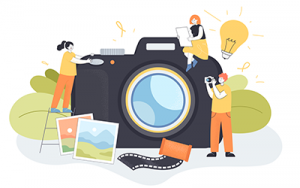You don’t have to be Annie Leibovitz or Rankin to sell photos. Anyone can do it. And you don’t have to have fancy equipment or be a professional photographer. If you have a smartphone, you could turn a glorious sunrise into a great profit. In this article we’ll look at how to sell photos online and make money.
Best camera for beginners
“The best camera is the one that’s with you”, according to award-winning photographer, Chase Jarvis. Jarvis wanted people to know that the type of gear isn’t the most important thing in photography. Instead, he says, “photographs are not about megapixels or dynamic range, but stories and moments.” While there’s something in that, tech, practice, and skill do play a large role in good photography.
So what is the best camera for beginners and what else do you need in your photography kit?
Camera
There are two main categories of camera: film and digital. Film is considered more old-school but is making a comeback. And with scanning, film pictures can be digitalised (once they’ve been developed). Digital cameras, however, have a lot more features and are more instant. You can pretty much upload an image onto the internet as soon as you’ve made it.
A DSLR (digital single-lens reflex) camera often brings a better, or higher, quality of photo than film. The shutter speed is faster, the focus is sharper, and there’s a huge range of settings available – all within the camera. There are hundreds of makes and models in production, with different sensors, ISO capabilities, and formats. But what is the best camera for beginners? Luckily there are numerous reviews on pretty much every camera out there. Amateur and professional photographers, camera sellers, and tech companies all have something to say. So listen to them; do as much research as possible and pick a camera that works for you. TechRadar recently published this article: “Best camera for beginners 2021: 12 top cameras for learning photography”, which is a good place to start.
Or…you could just use your iPhone. That’s what Chase Jarvis was talking about in the quote we used earlier. Since the introduction of the first commercial camera phone in 1999, the technology has advanced rapidly. Smartphones now feature cameras with megapixels, lenses, and image sensors powerful enough to rival regular cameras. Digital Camera World recently looked at “The best iPhone for photography in 2021: from the iPhone 7 to iPhone 12 Pro”.
In 2015, Apple launched their “Shot on iPhone” campaign to celebrate the camera on the iPhone 6. Instead of hiring professional photographers with ‘fancy’ equipment, Apple used photos taken by ‘ordinary’ people using the iPhone 6. They chose 162 images which had been uploaded to Facebook, Flickr, and Instagram and showed the campaign across the world. The campaign showed that amateur photographers could shoot photographs worthy of appearing in an international campaign. If they used an iPhone…
Lens
Some cameras come with a fixed lens which means that you can’t change to another one. However, other cameras let you unscrew the lens. There are lots of different types of lenses to choose from but they come in two main categories: prime and zoom. A prime lens has a fixed focal length whilst a zoom lens lets you zoom in and out (moving things closer or further away). The three most popular standard primes lenses are the 35mm, 50mm, and 85mm lenses. Zoom lenses come in a range of focal lengths such as 18-55mm, 16-80mm, and 24-105mm, and usage depends on the type of photography.
A lot of cameras come with a kit, or ‘starter’, lens. This type of lens is usually quite cheap (in terms of lenses) and can be good for beginners. However, you might decide to try something else, especially if you’re wanting to specialise in a specific style of photography. For example, telephoto lenses (100-600mm) are often used in wildlife photography and macro lenses (50-200mm) are a favourite of many wedding photographers.
Other types of lenses:
- A ‘Nifty Fifty’ (50mm) is a lens you’ll find in most photographers’ kit bags. It is considered a ‘normal’ lens and focal length because it mimics what the eye sees. Often used in street photography and portraiture shots.
- Wide-angle lenses (24-35mm) are often used for landscapes or by estate agents for interior shots.
- Fisheye lenses (8-24mm) are ultra-wide angle lenses which create distortion. They’re mostly used for abstract and panoramic shots.
- Super-telephoto lenses (400-2000mm) are specialist telephoto lenses usually reserved for use by professionals shooting events or astronomy.
- Tilt-shift lenses (17-35mm) are prime lenses great for architecture and fine art as they allow you to modify the focal plane, to correct distortions
Any photographer’s advice would be to practice with what you have available. Yes, some shots are only achievable with a certain type of lens, but amazing shots can be taken with anything.
SD card
SD, or memory, cards are used for storage. And depending on the camera you use, the size of your photo files can be big. Cameras usually have one or two card slots, so make sure you check before taking photos. Each memory card has a write speed and a read speed, as well as storage capacity. SanDisk is a popular brand of SD card and comes in many models and sizes (eg SanDisk Extreme PRO 128GB).
Editing tools/apps
Once you’ve taken a photo, it’s time to make it look its absolute best. Editing is something that you can spend as much or as little time on as you want. And thanks to photo editing apps like Adobe Lightroom, Snapseed, and VSCO, it can be done on-the-go.
Editing photos is a completely different skill to taking them. So don’t worry if you haven’t had much experience aside from picking an Instagram filter. Presets are a great way to change the look of a photo without having to fiddle around with too many settings. They can also give your images a consistent style which is good if you’re looking to develop a brand. You can either make your own presets or buy them from other photographers.
Accessories
Less essential than a camera for actually taking a photo, but still part of the kit, are camera accessories. For example, if you do a lot of landscape or wildlife photography, a tripod will come in handy. Likewise, some photographers use filters. We’re not talking Insta filters. Camera lens filters can reduce reflections, glare, and the amount of light that enters the lens. And while bags, straps, and card readers won’t have much impact on your photography skills, they’re still worth thinking about. There’s also lighting rigs, backdrops, shutter buttons…
As a beginner, the best photography kit for you is the one you have available.
How to sell stock photos online
What is stock photography?
Stock photography is a library of images which can be bought, sold, and licensed out. Stock images are used on websites, blogs, and ads. Depending on the stock library, the photographer earns money with each download. There are various types of stock library, including macrostock, midstock, and microstock which offer different levels of rights. For this article, we’ll look at some of the smaller (microstock) sites. These stock sites may pay just pennies to pounds, but they’re a great source of passive income.
Best stock photo sites
Shutterstock
Shutterstock is one of the most well-known and best stock photo sites. As a contributor, you will make money every time someone downloads one of your photos from the stock library. With Shutterstock’s dedicated contributor app, you can upload and submit images straight from your phone. Which is great when you’re shooting and editing on-the-go. You can also track your earnings and see which images are performing well. The Shutterstock Academy has loads of great tips for taking awesome stock photos.
iStock
iStock is owned by Getty Images and it’s kind of invitation only. You have to upload 3 to 6 sample images to the Contributor by Getty Images app. These will be reviewed and if accepted, you’ll be invited to join either iStock or Getty Images as a contributor. The amount you can earn depends on the image’s sales price and exclusivity to the site.
Foap
Foap is primarily an app, which makes it perfect for selling photos online. Photographers, or Creators, submit images in response to a brands’ briefs. On Foap a brief is called a Mission. Pick a Mission and upload a picture that reflects what the brand is after. If your work is picked, the profits are split 50/50 between you and the platform. It’s a great way to make money selling your photos online.
Alamy
Stock library Alamy pays up to 50% for any photographs you sell through their site. Images that aren’t exclusive to Alamy will be worth less. And there’s even better news for students. If your university is registered to Alamy’s ‘100% students’ scheme, then you will receive 100% of the sales price of your photos. There are two ways for beginner photographers to sell photos online with Alamy: work directly with clients or sell your images as stock and earn a commission on each sale. Payments are made monthly once you’ve reached the minimum payout amount of $50.
Other stock imagery sites include fotoLibra, EyeEm, and Dreamstime. Some sites offer more money for exclusive images. However, it’s worth signing up to a number of platforms so that you have more chances to get your photos used. Always check the terms and conditions of a site before you join.
If you are particularly skilled at photography, you could even transfer these skills to an online course, in which you could make money with online workshops.
Selling photo prints
If you don’t want to sell your photos to a stock library, there are still plenty of ways for you to make money. For example, you could sell digital or printed copies of your images. And you could either list them via your own website or social platforms, or on a gallery site. Look for integration options to make sure things run smoothly. For example, if you want to sell photos online via Facebook, you can integrate Shopify for multi-channel selling.
Picfair
Picfair lets photographers sell their images in both digital and printed format. If someone buys a download, they handle the licences. And if someone buys your image as a print, they produce, pack, and send it out to them. With Picfair, you set up an online store and choose which photos and products to offer.
It’s worth thinking about how you want to offer your photos when selling. And shopping around when it comes to where to sell from, choosing a printer, and distribution methods. If you choose to sell prints, you’ll need to think about paper type, ink type, size, and whether the piece comes framed or unframed. These can all add onto your upfront costs which can seem quite overwhelming when you’re just starting out.
Make and sell photobooks
Print is most certainly not dead. Especially when it comes to photos. More and more people are (re)discovering the joy of printing their photos out. Whether it’s for analogue albums, to hang on the wall, or for a photobook.
Photobooks are a fantastic way to showcase your pictures. Both for personal and commercial use. If you don’t have a traditional publishing deal, self-publishing is a great option for producing a photobook. Blurb lets you design, print, and sell (via their bookstore) your own photobook. Choose the size of your book, as well as the type of paper and cover type. Once you’ve designed your photobook using the free software Bookwright, you can pay for printed copies to then sell.
If you don’t want to house physical stock but making and selling photobooks interests you, then you can use a print-on-demand service instead. We’ll look at what print-on-demand is in a moment.
Another option would be to run an online photobook store. It’s certainly a niche, but it means that you can really focus on finding your target audience. Hone your SEO skills and instead of being ‘just’ another online bookstore, stand out from the crowd. Photobook Junkies do just that and have an awesome collection of photobooks for sale.
Sell print-on-demand products
What is print-on-demand?
Print-on-demand (pod) is a printing technology where things aren’t printed until an order has been placed. Instead of having to commit to large print runs, you can just print a single piece or small quantities. This can be useful if you want to sell your photographs but don’t want to hold hundreds of copies in stock.
Print-on-demand can also be used for other products, not just photos. For example, with services like Printful, you can sell more products. Put your photography on other items and expand your money-making opportunities!
Sell photos to online magazines
Some magazines accept image submissions to use alongside their written content. Each magazine will have its own guidelines on what kind of thing they’re looking for.
But be aware that not all of them will pay you for your work. It can be quite daunting to price your work or to think about its worth. This article talks about how much some magazines will pay for photographs. If you don’t feel comfortable selling your photos to online publications yourself, you could use an agency instead. They act as a middleman, have a good idea of what will or won’t sell, and should be able to give you an idea of price quite quickly.
Since we’re in the world of magazines, let’s take a quick look at editing and retouching. Although it’s a different skill to photography, it could be something you add to your skillset. You’ll probably have to set up on a freelance basis but it’s another potential route for making money.
Patreon approach
Patreon allows artists and content creators to interact directly with their ‘fans’. Once you’ve built an audience on social media, for example, you can start a Patreon to request monthly donations. At the time of writing (August 2021), there are 1600 creators in Patreon’s Photography category. For more information on how to make money as a content creator see our article What is Patreon?.
Patreon can produce a lot of extra work as you need to create ‘rewards’ for your patrons. Another option would be something like Ko-fi or Buy Me a Coffee, which we also talk about in the What is Patreon? article. Then, add a donate button or link to your website, blog, or social accounts and make money on a passive basis.
How about stepping into the world of moving pictures? Platforms like LADBible, pay for videos or content that they feature on their Facebook page or website. So if you capture “an epic fail, an awesome bit of skill or a moving story of overcoming adversity”, think about sending it their way. If your video, photo, or story is featured, they’ll pay £100.
As well as selling photos, there are so many other ways to make money online through photography. Photography is like a language all of its own.
Teach online photography classes
We all know the saying: “those who can’t, teach”…except you can! Which makes you the ideal person to teach. Many photographers make money by teaching photography. And this doesn’t have to be in a formal, educational setting. As long as you’re confident in your abilities, you can teach others. This can be done in the form of an online course, an ebook, or even a portfolio review.
Although offline, a photography tour can be a great way to ‘teach’ on the go. Get a group together, pick a location, and offer attendees training on how to use their camera or how to improve their photography.
Write a photography blog
They say a picture tells a thousand words. So if you’ve got something to say, share, or show, why not start a photography blog? This isn’t necessarily a quick way to make money because blogs are something which build over time.
How to start a photography blog (the basics)
Choose a name, niche, and brand identity
Although you can finesse or refresh your brand anytime, it’s a good idea to pick a starting place. Before you start, you need to think about what you want to use your photography blog for. What do you want to talk about and how do you want to say it?
Pick a platform
Make sure the domain name you want is available and get it registered. You’ll need to choose a web host. Some of the most popular are SquareSpace, GoDaddy, Bluehost. There are also free blogging platforms such as Wix.
Build or customise your blog
Choose a template or dig out your coding skills in order to make your blog match your brand. Since you’re creating a photography blog, you might want to pick a gallery template. Or if you know you have a lot to say, pick templates which lay text out clearly.
Plan, write, and schedule your content
Consistency is key when it comes to publishing content. That’s why a plan is so important. The other important thing is to write with purpose. There’s a lot of noise on the internet, so make sure your content is useful. Then make sure people can find it…
Spread the word
Whether you choose to go all-in on SEO (search engine optimisation), cross-channel marketing, or paid advertising, you need to spread the word. You’re making a blog to be seen. And on top of that, you’re making it to earn some money from, too. For that to happen, people need to be able to find and visit it.
Monetise
At the start, the best way to monetise your photography blog would be through onscreen ads or affiliate marketing. Is there a piece of kit that you couldn’t live without? Encourage someone to buy it: write a review, share photos, and always include an affiliate link. However, as your blog grows in audience size, you could add more money-making options. For example, sell prints of your photos, run workshops, or even sell your old kit.
Start a photography podcast
Everyone listens to podcasts these days. And if they don’t, they maybe just haven’t found the right one yet. Could yours be the one they’re waiting for? There are lots of photography podcasts available that cover a whole range of niches, areas, and styles. But if you have a genuine interest in photography, you’ll have a different voice to add.
If you’re not already a professional broadcaster or sound engineer, you’ll probably need to spend a bit of money on equipment. And a podcast probably isn’t going to earn you thousands of pounds in income. However, you should be able to make money from a photography podcast through adverts or affiliate marketing. As your listener numbers grow, you could scale and sell photography kit or attract sponsorship.
Host a photography channel or vlog
Photography is a visual medium. So let’s take a look at a more visual version of a blog or podcast…
YouTube is home to thousands of videos about photography. And there are hundreds of photography channels too. But that doesn’t mean that there isn’t room for you. It’s not what you say, it’s how you say it. The reason there are so many photography channels is because people are looking for different things in their video content. Not everyone wants to watch the same thing. So if you wanted to review a certain camera, but there are already video reviews online, make sure yours is different. Make it engaging, interesting, well-made, fun-to-watch, and full of useful information.
Here’s a great tutorial for anyone looking to start a photography channel on YouTube. You’ll also find some examples of people who have already started their own below:
Frame Lines
Created by Josh Edgoose (ig: @spicy.meatball) and Shane Taylor (ig: @heroesforsale) Frame Lines does a few things. As well as doing photowalks and street photography around London, they also share photobooks, interview other photographers, and review cameras. It’s a great mix of interesting content and there’s always something to learn.
Vuhlandes
Vuhlandes knows that he’s probably not most people’s idea of a typical photographer. And that shapes a lot of his photography channel’s content. He lives in Detroit and credits his surroundings for influencing his “unique, street, gritty but clean style” of photography. As well as documenting his locale, Vuhlandes shoots film and shares both film and digital camera reviews.
Jessica Kobeissi
Jessica’s YouTube channel is a real mix of things. But on there you’ll find editing tutorials, photography challenges, and behind-the-scenes vlogs of photoshoots and street portraiture.
On YouTube, you can earn revenue from adverts and by adding relevant affiliate marketing links to your videos’ captions. Other photography YouTubers advertise their own courses or workshops. For example, photographer Sorelle Amore includes information about her Advanced Selfie course in her YouTube videos.
On social media
Chances are that you use at least one of the main social media platforms. Now it’s time to think about how to monetise them. Instead of ‘Likes’ and thumbs up, earn money. For example, start an Instagram account specifically for your photography. Research styles, use relevant hashtags, and interact with people to build a following. This probably won’t be a quick process, but growing an audience organically helps you attract the ‘right kind’ of follower. Hopefully, one that’s a potential customer. Once you have people engaging with your content, you can start to make money through affiliate marketing, sponsored content, and ads. Or add a Patreon link to your bio!
Contests and competitions
Entering photography competitions is a great way to get your work seen and hopefully bag yourself a prize too. You can also use photo contests to see what other people are doing, take inspiration, and see how your work fits in. There are online photo competitions running all the time for amateurs, professionals and everyone in between. Some photo contests offer cash prizes whilst others offer exposure, tech, or training to winners. So if you’re purely in it for the money, check out the prize list first.
Other things to do when researching which photography competitions to enter is to look at previous winners, the judges, and cost of entry. You’ll also need to look at the submission guidelines and image specifications of each contest to ensure your entry is eligible. Here are a few photography competitions with cash prizes to get you started:
- Sony World Photography Awards. First prize: (Professional: $25,000 and Open: $5,000)
- RHS Photographic Competition. First prize: £5,000
- ND Awards. First prize: $7,500
- Amateur Photographer of the Year. Various cash and vouchers prizes available.
- Taylor Wessing Photographic Portrait Prize. First prize: £15,000
How to sell photos offline…
While this article is about how to sell photos online and make money, the act of photography is primarily an offline activity. Saying that, some photographers held virtual or remote photoshoots during the COVID-19 lockdown…
However, there are a number of offline opportunities where you can also make money by selling photos. Look for opportunities in your local area. For example, approach small businesses and offer to take some photographs that they can use for social media, etc. Depending on your confidence, sales technique, and possibly your existing portfolio you may or may not get paid for this. If not, it’s a great way to build a portfolio. But always be aware of how much work and time you give away for free. Read our article “What is freelancing?” for more general information about how to make money doing freelance work.
Other local opportunities:
- Family or individual portraits
- End-of-school-year photoshoots
- Local sport or music events.
It can pay to ask. Even if you’re not paid much at the beginning, you’ll have made a connection. One that you can hopefully turn into a repeat or long term client.
If freelancing is particularly up your avenue, you could check out how to sell on fiver as this is a great marketplace for selling services online.
How to become a freelance photographer
If you’re interested in doing something like the photoshoots mentioned above, it might be worth thinking about how to be a freelance photographer. Freelance photography can still be done as a side hustle, but it’s more about formalising things. Being a freelancer can help to ‘legitimise’ your work in the eyes of potential clients. And it could help you take your photography to the next level.
Become a freelance photographer
Build a portfolio
Take as many photos as you can. If you’ve already been doing photography as a side hustle, you should have lots of images in your portfolio already. Sort these into styles and showcase them properly. If possible, join a professional photographer as an assistant. You could accompany them as a second shooter at a wedding. This will give you real-world examples of the type of images you could produce for your own clients.
Network and build relationships
As with any freelance work, you have to go out and find it. Or, you have to know how to market your services so that potential clients can find you. Talk to other freelance photographers, join communities, and hand your card out whenever you get the opportunity.
Be organised
Organising your time is important, especially if you’re doing freelance photography alongside employment. Maintain a schedule and keep it updated. Communication with clients is an important part of this too, as you could waste a lot of time waiting to hear back.
Manage your finances
In the UK, anyone who is self-employed needs to register with HMRC. You can choose to operate as either a sole trader or a limited company. Depending on which route you take, you’ll need to pay income tax and National Insurance contributions, corporation taxes. Insurance is another financial area that you’ll need to think about if you become a freelance photographer. A specialist adviser will be able to talk you through things like public liability insurance, professional indemnity insurance, and contents insurance.
Other ways to make money online
There are other ways to make money online. In this article we talked about how affiliate marketing is a great way for photographers to top up their income.
Matched betting is a technique that helps you turn the free promotional bets offered by bookmakers into real profit. Because you bet on and cover all potential outcomes, the only way you can lose money is if you make a mistake. Check out our ‘What is matched betting?’ guide to find out what you need to do to get started.






